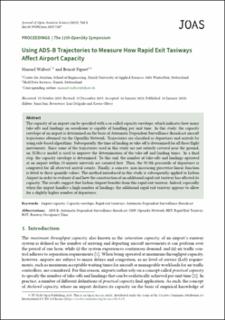Please use this identifier to cite or link to this item:
https://doi.org/10.21256/zhaw-29322| Publication type: | Conference paper |
| Type of review: | Open peer review |
| Title: | Using ADS-B trajectories to measure how rapid exit taxiways affect airport capacity |
| Authors: | Waltert, Manuel Figuet, Benoit |
| et. al: | No |
| DOI: | 10.59490/joas.2023.7207 10.21256/zhaw-29322 |
| Published in: | Journal of Open Aviation Science |
| Proceedings: | The 11th Opensky Symposium |
| Volume(Issue): | 1 |
| Issue: | 2 |
| Conference details: | 11th Opensky Symposium, Toulouse, France, 30-31 October 2023 |
| Issue Date: | 31-Oct-2023 |
| Publisher / Ed. Institution: | TU Delft Open Publishing |
| Language: | English |
| Subjects: | Airport capacity; Capacity envelope; Rapid exit taxiways; Automatic Dependent Surveillance-Broadcast |
| Subject (DDC): | 380: Transportation |
| Abstract: | The capacity of an airport can be specified with a so-called capacity envelope, which indicates how many take-offs and landings an aerodrome is capable of handling per unit time. In this study, the capacity envelope of an airport is determined on the basis of Automatic Dependent Surveillance-Broadcast aircraft trajectories obtained via the Opensky Network. Trajectories are classified as departures and arrivals by using rule-based algorithms. Subsequently, the time of landing or take-off is determined for all these flight movements. Since some of the trajectories used in this study are not entirely covered near the ground, an XGboost model is used to improve the determination of the take-off and landing times. In a final step, the capacity envelope is determined. To this end, the number of take-offs and landings operated at an airport within 15-minute intervals are counted first. Then, the 92.5th percentile of departures is computed for all observed arrival counts. Finally, a concave, non-increasing piecewise-linear function is fitted to these quantile values. The method introduced in this study is subsequently applied to Lisbon Airport in order to evaluate if and how the construction of an additional rapid exit taxiway has affected its capacity. The results suggest that Lisbon Airport benefits from this rapid exit taxiway. Indeed, especially when the airport handles a high number of landings, the additional rapid exit taxiway appears to allow for a slightly higher number of departures. |
| URI: | https://digitalcollection.zhaw.ch/handle/11475/29322 |
| Fulltext version: | Published version |
| License (according to publishing contract): | CC BY 4.0: Attribution 4.0 International |
| Departement: | School of Engineering |
| Organisational Unit: | Centre for Aviation (ZAV) |
| Appears in collections: | Publikationen School of Engineering |
Files in This Item:
| File | Description | Size | Format | |
|---|---|---|---|---|
| 2023_Waltert-Figuet_Using-ADS-B-trajectories-airport-capacity_JOAS.pdf | 936.88 kB | Adobe PDF |  View/Open |
Show full item record
Waltert, M., & Figuet, B. (2023). Using ADS-B trajectories to measure how rapid exit taxiways affect airport capacity [Conference paper]. Journal of Open Aviation Science, 1(2). https://doi.org/10.59490/joas.2023.7207
Waltert, M. and Figuet, B. (2023) ‘Using ADS-B trajectories to measure how rapid exit taxiways affect airport capacity’, in Journal of Open Aviation Science. TU Delft Open Publishing. Available at: https://doi.org/10.59490/joas.2023.7207.
M. Waltert and B. Figuet, “Using ADS-B trajectories to measure how rapid exit taxiways affect airport capacity,” in Journal of Open Aviation Science, Oct. 2023, vol. 1, no. 2. doi: 10.59490/joas.2023.7207.
WALTERT, Manuel und Benoit FIGUET, 2023. Using ADS-B trajectories to measure how rapid exit taxiways affect airport capacity. In: Journal of Open Aviation Science. Conference paper. TU Delft Open Publishing. 31 Oktober 2023
Waltert, Manuel, and Benoit Figuet. 2023. “Using ADS-B Trajectories to Measure How Rapid Exit Taxiways Affect Airport Capacity.” Conference paper. In Journal of Open Aviation Science. Vol. 1. TU Delft Open Publishing. https://doi.org/10.59490/joas.2023.7207.
Waltert, Manuel, and Benoit Figuet. “Using ADS-B Trajectories to Measure How Rapid Exit Taxiways Affect Airport Capacity.” Journal of Open Aviation Science, vol. 1, no. 2, TU Delft Open Publishing, 2023, https://doi.org/10.59490/joas.2023.7207.
Items in DSpace are protected by copyright, with all rights reserved, unless otherwise indicated.